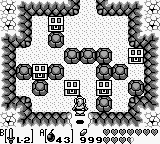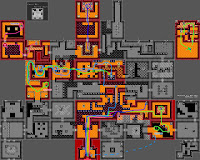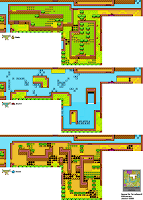
My super awesome The Magic of Link's Awakening article just totally motivated me to replay Link's Awakening yet another time. I actually wanted to wait until I get myself a Nintendo 3DS to play the Virtual Console copy, but I just couldn't resist anymore. But I played the original monochrome version to have some difference and I also made tons of screenshots during my replay, so it wasn't for nothing. Like already stated in the article, the game is quite short. It took my only about four hours to fully complete it (100%ed), I did it in one run without any pauses. Just one evening. This wouldn't be possible with any other Zelda game, most of them take their time, especially if you want to finish all sidequests as well. The NES classics might be also short, but Hyrule Fantasy got its 2nd Quest, which will keep you busy, and Zelda II is just plain hard, you won't blast through as easily here. However, especially because Link's Awakening is so short but luscious, it's the Zelda game with highest replay value in my eyes. This game is always worth another replay. And such a game is perfectly suited for a handheld system, unlike the slow, boring and articially stretched Spirit Tracks for example. I was always rooting that Zelda gets more intense again, really challenging on your first playthrough and fun to replay. But Zelda games got more and more bloated. I thought the WiiWare service would be perfect for another Link's Awakening style Zelda game, but Nintendo never really used WiiWare as a potential platform.
Since I already talked about all the great things in this game in my article, I can save you the big talk and focus on some details.
One detail would be the censorship. The US version of the game actually got censored. In Germany you cleary notice this, because the original version was based on the uncut Japanese version. And our DX version was based on the US one. So, being confronted with those changes felt a little weird. One thing would be the hippo lady inside the house of the crocodile painter. She is posing nude and in the original version she got tits... in the other version she doesn't. No big deal, but they also changed the Mermaid part of the trading sequence. In original she lost her bikini and if you dive in front of her she gets totally upset, because Link is a perv and all. This got replaced by losing her necklace and if you dive she just says "I looked there before".
This game has so many interesting stuff, other Zelda games don't have. Especially in the dungeons. What I love are the key sounds, when you got the Compass and you enter a room with a key hidden inside. Just cool. Okay, the Oracle games got this as well, but I really miss this in other games. And what absolutely no other game has are those revolving doors, which you can only enter from one side. Kind of silly, but also a neat idea. It's some sort of one way passage. Or there are those card symbol enemies and you have to hit them in the right time, so all three of them show the same symbol. Or those stupid Knight chess figures, which you have to toss until both are upright. Talking about that, there's this one nasty room at the end of Level 7 which I totally hate. This one:

Since you have to toss the Knight figures around, defending yourself from the Beamos is difficult. Additionally the conveyor makes the Beamos extra nasty, he shoots you three times in a row. I lost a potion in this room! In the DX version you would get a new potion from the treasure chest, but the classic version only gives you 100 rupees. This money is not worth nearly dying.
Did I ever mention the puzzle, which took me ten years to solve? No kidding. It's about one hidden room in the mountains on your way to Level 7. There are five treasure chests, but if you leave the room, they all will be gone. This is how the room looks like:

You normally enter the room from the upper entrance. My goal always was to open all five, but I never could do it. I even tried plunging from the bridge above the cave (like the photo mouse guy in the DX version), so I could enter the room from the south side, where opening all chests would easily be possible. The solution actually is totally simple. If you don't touch any of the chests, they stay closed. So, you just leave the room through the south door and come back in (like pictured above). For some reason I always assumed that all treasure chests will be gone, if I leave the room, no matter what. Probably some disbelief I got as a kid, it's hard to get rid of something like that. However, in a replay four years ago, ten years after I originally played the game I finally had figured it out... that's one hell of a puzzle. (Though it doesn't really matter, if you screw it up. The chests just contain rupees.)
In my article I showed you a sketch for a solution of Turtle Rock, where you skip about 50% of the rooms. Naturally I tried this during my replay, to see if this really works and that I wasn't just talking bullshit. But here's the proof:

I got the map after I've beaten the dungeon. You can clearly see that the boss is gone and you can see all the rooms, which I haven't visited. I skipped 54% of the entire dungeon, 25 of 46 rooms. Not bad, eh?
So, replaying Link's Awakening was short, but tons of fun like always. I love this game and there isn't any other game, which I know as well as this one. Do yourself a favor and pick this game up, if you haven't yet.

Since I already talked about all the great things in this game in my article, I can save you the big talk and focus on some details.
One detail would be the censorship. The US version of the game actually got censored. In Germany you cleary notice this, because the original version was based on the uncut Japanese version. And our DX version was based on the US one. So, being confronted with those changes felt a little weird. One thing would be the hippo lady inside the house of the crocodile painter. She is posing nude and in the original version she got tits... in the other version she doesn't. No big deal, but they also changed the Mermaid part of the trading sequence. In original she lost her bikini and if you dive in front of her she gets totally upset, because Link is a perv and all. This got replaced by losing her necklace and if you dive she just says "I looked there before".
This game has so many interesting stuff, other Zelda games don't have. Especially in the dungeons. What I love are the key sounds, when you got the Compass and you enter a room with a key hidden inside. Just cool. Okay, the Oracle games got this as well, but I really miss this in other games. And what absolutely no other game has are those revolving doors, which you can only enter from one side. Kind of silly, but also a neat idea. It's some sort of one way passage. Or there are those card symbol enemies and you have to hit them in the right time, so all three of them show the same symbol. Or those stupid Knight chess figures, which you have to toss until both are upright. Talking about that, there's this one nasty room at the end of Level 7 which I totally hate. This one:

Since you have to toss the Knight figures around, defending yourself from the Beamos is difficult. Additionally the conveyor makes the Beamos extra nasty, he shoots you three times in a row. I lost a potion in this room! In the DX version you would get a new potion from the treasure chest, but the classic version only gives you 100 rupees. This money is not worth nearly dying.
Did I ever mention the puzzle, which took me ten years to solve? No kidding. It's about one hidden room in the mountains on your way to Level 7. There are five treasure chests, but if you leave the room, they all will be gone. This is how the room looks like:

You normally enter the room from the upper entrance. My goal always was to open all five, but I never could do it. I even tried plunging from the bridge above the cave (like the photo mouse guy in the DX version), so I could enter the room from the south side, where opening all chests would easily be possible. The solution actually is totally simple. If you don't touch any of the chests, they stay closed. So, you just leave the room through the south door and come back in (like pictured above). For some reason I always assumed that all treasure chests will be gone, if I leave the room, no matter what. Probably some disbelief I got as a kid, it's hard to get rid of something like that. However, in a replay four years ago, ten years after I originally played the game I finally had figured it out... that's one hell of a puzzle. (Though it doesn't really matter, if you screw it up. The chests just contain rupees.)
In my article I showed you a sketch for a solution of Turtle Rock, where you skip about 50% of the rooms. Naturally I tried this during my replay, to see if this really works and that I wasn't just talking bullshit. But here's the proof:

I got the map after I've beaten the dungeon. You can clearly see that the boss is gone and you can see all the rooms, which I haven't visited. I skipped 54% of the entire dungeon, 25 of 46 rooms. Not bad, eh?
So, replaying Link's Awakening was short, but tons of fun like always. I love this game and there isn't any other game, which I know as well as this one. Do yourself a favor and pick this game up, if you haven't yet.




























